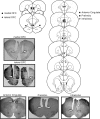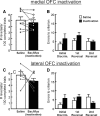Multifaceted Contributions by Different Regions of the Orbitofrontal and Medial Prefrontal Cortex to Probabilistic Reversal Learning
- PMID: 26865622
- PMCID: PMC6602019
- DOI: 10.1523/JNEUROSCI.3366-15.2016
Multifaceted Contributions by Different Regions of the Orbitofrontal and Medial Prefrontal Cortex to Probabilistic Reversal Learning
Abstract
Different subregions of the prefrontal cortex (PFC) contribute to the ability to respond flexibly to changes in reward contingencies, with the medial versus orbitofrontal cortex (OFC) subregions contributing differentially to processes such as set-shifting and reversal learning. To date, the manner in which these regions may facilitate reversal learning in situations involving reward uncertainty remains relatively unexplored. We investigated the involvement of five distinct regions of the rat OFC (lateral and medial) and medial PFC (prelimbic, infralimbic, and anterior cingulate) on probabilistic reversal learning wherein "correct" versus "incorrect" responses were rewarded on 80% and 20% of trials, respectively. Contingencies were reversed repeatedly within a session. In well trained rats, inactivation of the medial or lateral OFC induced dissociable impairments in performance (indexed by fewer reversals completed) when outcomes were probabilistic, but not when they were assured. Medial OFC inactivation impaired probabilistic learning during the first discrimination, increased perseverative responding and reduced sensitivity to positive and negative feedback, suggestive of a deficit in incorporating information about previous action outcomes to guide subsequent behavior. Lateral OFC inactivation preferentially impaired performance during reversal phases. In contrast, prelimbic inactivation caused an apparent improvement in performance by increasing the number of reversals completed. This was associated with enhanced sensitivity to recently rewarded actions and reduced sensitivity to negative feedback. Infralimbic inactivation had no effect, whereas the anterior cingulate appeared to play a permissive role in this form of reversal learning. These results clarify the dissociable contributions of different regions of the frontal lobes to probabilistic learning.
Significance statement: The ability to adjust behavior in response to changes involving uncertain or probabilistic reward contingencies is an essential survival skill that is impaired in a variety of psychiatric disorders. It is well established that different forms of cognitive flexibility are mediated by anatomically distinct regions of the frontal lobes when reinforcement contingencies are assured, however, less is known about the contribution of these regions to probabilistic reinforcement learning. Here we show that different regions of the orbitofrontal and medial prefrontal cortex make distinct contributions to probabilistic reversal learning. These findings provide novel information about the complex interplay between frontal lobe regions in mediating these processes and accordingly provide insight into possible pathophysiology that underlies impairments in cognitive flexibility observed in mental illnesses.
Keywords: orbitofrontal cortex; prelimbic cortex; probabilistic; reversal learning.
Copyright © 2016 the authors 0270-6474/16/361996-11$15.00/0.
Figures





Similar articles
-
Preferential involvement by nucleus accumbens shell in mediating probabilistic learning and reversal shifts.J Neurosci. 2014 Mar 26;34(13):4618-26. doi: 10.1523/JNEUROSCI.5058-13.2014. J Neurosci. 2014. PMID: 24672007 Free PMC article.
-
Modulation of value-based decision making behavior by subregions of the rat prefrontal cortex.Psychopharmacology (Berl). 2020 May;237(5):1267-1280. doi: 10.1007/s00213-020-05454-7. Epub 2020 Feb 6. Psychopharmacology (Berl). 2020. PMID: 32025777 Free PMC article.
-
Dissociable contributions of the orbitofrontal and infralimbic cortex to pavlovian autoshaping and discrimination reversal learning: further evidence for the functional heterogeneity of the rodent frontal cortex.J Neurosci. 2003 Sep 24;23(25):8771-80. doi: 10.1523/JNEUROSCI.23-25-08771.2003. J Neurosci. 2003. PMID: 14507977 Free PMC article.
-
Involvement of basal ganglia and orbitofrontal cortex in goal-directed behavior.Prog Brain Res. 2000;126:193-215. doi: 10.1016/S0079-6123(00)26015-9. Prog Brain Res. 2000. PMID: 11105648 Review.
-
New functions of the rodent prelimbic and infralimbic cortex in instrumental behavior.Neurobiol Learn Mem. 2021 Nov;185:107533. doi: 10.1016/j.nlm.2021.107533. Epub 2021 Oct 18. Neurobiol Learn Mem. 2021. PMID: 34673264 Free PMC article. Review.
Cited by
-
Role of Orbitofrontal Cortex and Differential Effects of Acute and Chronic Stress on Motor Impulsivity Measured With 1-Choice Serial Reaction Time Test in Male Rats.Int J Neuropsychopharmacol. 2022 Dec 12;25(12):1026-1036. doi: 10.1093/ijnp/pyac062. Int J Neuropsychopharmacol. 2022. PMID: 36087292 Free PMC article.
-
Dissociable roles for the ventral and dorsal medial prefrontal cortex in cue-guided risk/reward decision making.Neuropsychopharmacology. 2020 Mar;45(4):683-693. doi: 10.1038/s41386-019-0557-7. Epub 2019 Oct 25. Neuropsychopharmacology. 2020. PMID: 31652433 Free PMC article.
-
Unique features of stimulus-based probabilistic reversal learning.Behav Neurosci. 2021 Aug;135(4):550-570. doi: 10.1037/bne0000474. Behav Neurosci. 2021. PMID: 34460275 Free PMC article.
-
Amygdala-cortical collaboration in reward learning and decision making.Elife. 2022 Sep 5;11:e80926. doi: 10.7554/eLife.80926. Elife. 2022. PMID: 36062909 Free PMC article. Review.
-
Inhibition of noradrenergic signalling in rodent orbitofrontal cortex impairs the updating of goal-directed actions.Elife. 2023 Feb 20;12:e81623. doi: 10.7554/eLife.81623. Elife. 2023. PMID: 36804007 Free PMC article.
References
Publication types
MeSH terms
Substances
LinkOut - more resources
Full Text Sources
Other Literature Sources
Miscellaneous
